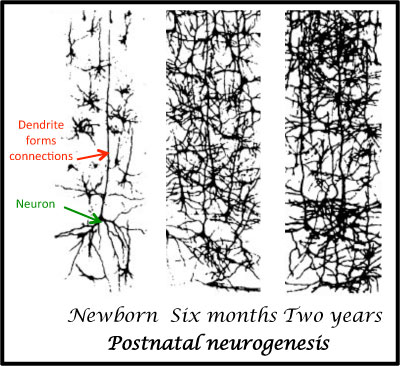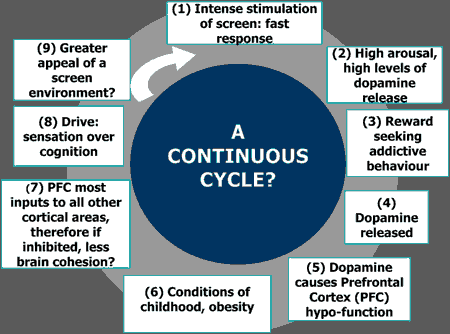Introduction to television and children
- How much television do children watch?
- Possible benefits of television
- Disadvantages of excessive television exposure
- Television and infants (0–24 months)
- Tips for managing television exposure
Introduction to television and children
In an increasingly screen-based society, the potential harmful effects of television on lifestyle and behaviour in children of all ages need to be carefully monitored.
In recent years, a number of programs have been introduced to television and DVDs which are specifically targeted at babies and toddlers. Thus, infants under two years of age are being exposed to television. The effects of television viewing on development in infants remain largely unknown, although the detrimental effects of television and media exposure during childhood are well documented.
How much television do children watch?

Another concerning trend is that an increasing number of children (approximately 70% of 8–18 year olds) have a television in their bedroom. Children with a television in their bedroom spend an average of 1.5 hours more per day watching TV.
Possible benefits of television
Many of the producers of childhood television programs (including Sesame Street, Nickelodeon, and Disney) employ child psychologists in order to develop programs that are both engaging and educational for young minds.
The benefits of television viewing include:
- Education;
- Promoting positive social messages;
- Promoting good parenting and strengthening the child–parent bond; and
- Exposure to positive role models.
Programs are often designed to teach young children things such as counting, colours, sounds and associations, in a fun and engaging way. These types of educational programs can be of great benefit if the child and parent watch the program at the same time, so that the experience is made more interactive and tangible to the child.
Promoting positive social messages
Many programs are based around a story that has some underlying morals. For example, a program may have undercurrents that promote friendships between people of different races, or that promote ‘doing the right thing’. These stories based on good manners and morality can produce positive social messages even in young children.
Promoting good parenting and strengthening the child–parent bond
Often programs are designed to be interactive between the infant/child and a parent, and the shows may even have parental and child characters. These shows are geared towards strengthening the child–parent bond. Some programs even have subtle ways of suggesting good parenting techniques.
Exposure to positive role models
Exposure through television to characters who are positive role models can result in children making positive lifestyle and behavioural changes themselves.
Disadvantages of excessive television exposure

Negative consequences include:
- Reduced socialisation;
- Unnecessary fear and sleep disturbances;
- Advertising-related issues;
- Subsequent health conditions;
- Effects on brain development; and/or
- Increased risk-taking behaviour in later life.
Children who spend more time watching screens, with or without parents or siblings present, spend less time interacting with family members.
Research on early brain development shows that babies and toddlers have a critical need for direct interaction with parents and other significant people for healthy brain growth and the development of appropriate social, emotional and cognitive skills.For these reasons and the lack of credible evidence showing a benefit of television viewing on child development, the American Academy of Pediatrics recommend that children under the age of two years should not be exposed to any television. It is well recognised that normal infant and toddler activities such as talking, singing, reading, listening to music and playing are far more beneficial to child development.
Unnecessary fear and sleep disturbances
Symptoms of being frightened or upset by screen viewing include bad dreams, anxious feelings, being afraid of being alone, withdrawing from friends, and sleep problems.Children under the age of eight cannot dissociate fantasy from reality and can become scared of make-believe characters (e.g. grotesque monsters). Children over the age of eight years become more frightened by real-life stories, and may become anxious that they may be a victim of violence or a natural disaster. Heightened fears that sometimes result from television, computer and gaming exposure can also impact on the child’s sleep pattern.
 |
For more information on good sleep practices, see Sleep Hygiene.
|

Exposure to alcohol advertising increases the likelihood a child will consume alcohol.10 Alcohol-related advertising in Australia is prohibited in children’s weekday time slots (before 12 noon, from 3-8.30pm), however at the weekends, public holidays and during live-to-air sporting events, alcohol-related advertising is permitted, even in these time frames. Children also often watch TV outside these time frames, and research shows that many children are exposed to alcohol advertising, and the advertising often uses marketing techniques which are particularly appealing to children (e.g. including animals in the advertisement).11
Reduced physical activity is an obvious consequence of excessive screen time, which takes away from time engaged in physical and outdoor activities.
Increasing body mass index (BMI) and obesity rates are a concerning trend in the current generation of children. It has been shown that, while watching screens, the metabolic rate slows to an even lower level than what occurs during rest. The combination of reduced metabolic rate, reduced levels of physical activity, increased food intake/snacking while watching television, and marketing of unhealthy foods are likely to impact significantly on childhood weight management.
Research has shown that just being awake and in a room with a television on for more than two hours a day is a risk factor for being overweight at age three and four-and-a-half years. Other studies have shown that an adult’s BMI is directly related to how much television they watched as a child – every extra hour of television watched per weekend as a 5-year-old results in a 7% increase in BMI at 30 years of age. Importantly, it has been shown that television viewing and lack of physical activity are most associated with the risk of being overweight in 3–6 year olds, and that the influence of television watching has a greater effect than does diet. Restricted television viewing has been shown to reduce excessive weight gain in pre-adolescents.
A number of studies have documented a correlation between television viewing, and elevated levels of blood glucose in children with type I diabetes and increased cholesterol levels in adulthood.
Increased rates of asthma may also be partly due to increased rates of screen viewing during childhood. Studies have shown that hours spent watching television as a child increase the risk of having asthma later in childhood.
Brain development: Cognitive function, imagination and creativity
A remarkable feature of human brain development is the extraordinary number of brain cell connections that develop during the first two years of life as a result of physical and emotional experiences. In this way, an infant’s realisation of the world changes from one that is purely sensory to a world that is cognitive and contains associations, perceptions and thinking based on previous experiences.
 |
| (Image courtesy of Prof S Greenfield) |
The environment is crucial to proper brain development. Research has shown that rats brought up in an enriched environment compared to a very plain environment have many more brain cell connections. The same is true of human brain cells. Thus, we need to consider very carefully the effects of modern technology and screens on young minds.
Screens are replacing reading and decreasing the amount of time children spend reading or being read to. Reading requires more cognition than TV viewing and fosters healthy brain development. TV watching is also associated with less time spent doing homework or engaging in creative play that stimulates the imagination (especially in children under five years of age). Television viewing is negatively correlated with school performance.
Other consequences of excessive television exposure include:
- Delayed speech in toddlers due to television exposure as infants;
- Exposure to excessive violence and desensitisation to violence and emotions (abnormal development of emotional cognition); and/or
- Increased incidence of attention-deficit hyperactivity disorder (ADHD) with poor memory and attention spans. It is thought that the fast and changing pace of television shows and other media results in incorrect wiring/connections in the brain which are then unable to cope with the normal slower pace of everyday life.
 |
For more information, see Childhood ADHD.
|
Increased risk-taking behaviour in later life

- Drug-taking;
- Smoking;
- Gambling;
- Borrowing too much credit, excessive debt;
- Unsafe sex and being sexually active at a younger age; and/or
- Over-eating.
These are thought to arise because of the lack of consequences in stories shown on television or played out on computers.
Another theory is that all of these risky behaviours stimulate the dopamine reward pathway in the brain’s prefrontal cortex. Excessive television also stimulates this reward pathway, so screen viewing and risky activities may be a form of addiction. It is thought that excessive screen activity during childhood may result in an increased likelihood of taking up other forms of addiction in later life. There are now designated centres for people with gaming addictions, highlighting the severity of the addictive nature of our screen culture.
 |
| (Image courtesy of Prof S Greenfield) |
Television and infants (0–24 months)
A remarkable period of brain development occurs during infancy and early childhood, in which 90% of a child’s brain wiring develops before five years of age. About 1.8 million connections are produced per second, from two months after conception until the baby is two years old.
Studies have shown that children learn better when being taught a task as a life demonstration, rather than when the task is being shown on a screen. Therefore, in addition to the detrimental consequences of excessive screen exposure on child brain development, cognition and socialisation, television shows aimed at infants and toddlers are less efficient at education compared with normal everyday play, learning and interactions.
Tips for managing television exposure
Do not place televisions or computers in children’s bedrooms;
- Monitor the amount of time spent in front of a screen;
- Set time limits for weekday and weekend screen times;
- Know what they are watching and monitor exposure to drama, violence and programs of a sexual nature if not age-appropriate;
- Watch programs and games with children so you can discuss issues arising from the content with them; and
- Do not use screen time as a ‘reward’ for good behaviour or as a parenting tool.
More information
 |
For more information on technology and its impact on health, childhood development and office injuries, as well as some useful videos, see Technology and Health. |
 |
For more information on parenting, including child development milestones, work-life balance and tips for spending more time with family, see Parenting. |
 |
For more information on brain health, including the anatomy of the brain, the effects of nutrition and exercise on the brain, and the effect of mental activity on health, see Brain Health.
|
References
- McDonagh P. TV viewing among kids at an eight-year high [online]. New York: The Nielson Company; 26 October 2009 [cited 25 August 2010]. Available from: URL link
- Rideout VJ, Foehr UG, Roberts DF. Generation M2: Media in the lives of 8-18 year-olds [online]. Menlo Park, CA: Kaiser Family Foundation; 20 January 2010 [cited 25 August 2010]. Available from: URL link
- Guernsey L. Into the minds of babes: How screen time affects children from birth to age five. Philadelphia: Basic Books; 2007. [Publisher]
- Vandewater EA, Bickham DS, Lee JH. Time well spent? Relating television use to children’s free-time activities. Pediatrics. 2006;117(2):e181-91. [Abstract |Full text]
- American Academy of Pediatrics Committee on Public Education. Media education. Pediatrics. 1999;104(2 Pt 1):341-3. Available from: [Abstract | Full text]
- Cantor J. “Mommy, I’m scared”: How TV and movies frighten children and what we can do to protect them. San Diego: Harcourt Brace; 1998. [Publisher]
- Thompson DA, Christakis DA. The association between television viewing and irregular sleep schedules among children less than 3 years of age. Pediatrics. 2005;116(4):851-6. [Abstract | Full text]
- Jain A. Temptations in cyberspace: New battlefields in childhood obesity. Health Aff (Millwood). 2010;29(3):425-9. [Abstract]
- Magnus A, Haby MM, Carter R, Swinburn B. The cost-effectiveness of removing television advertising of high-fat and/or high-sugar food and beverages to Australian children. Int J Obes (Lond). 2009;33(10):1094-102. [Abstract]
- Snyder LB, Milici FF, Slater M, et al. Effects of alcohol advertising exposure on drinking among youth. Arch Pediatr Adolesc Med. 2006;160(1):18-24. [Abstract | Full text]
- Fielder L, Donovan RJ, Ouschan R. Exposure of children and adolescents to alcohol advertising on Australian metropolitan free-to-air television. Addiction. 2009;104(7):1157-65. [Abstract | Full text]
- Cooper TV, Klesges LM, Debon M, et al. An assessment of obese and non obese girls’ metabolic rate during television viewing, reading, and resting. Eat Behav. 2006;7(2):105-14. [Abstract]
- Hancox RJ, Milne BJ, Poulton R. Association between child and adolescent television viewing and adult health: A longitudinal birth cohort study. Lancet. 2004;364(9430):257-62. [Abstract]
- Viner RM, Cole TJ. Television viewing in early childhood predicts adult body mass index. J Pediatr. 2005;147(4):429-35. [Abstract | Full text]
- Jago R, Baranowski T, Baranowski JC, et al. BMI from 3-6 years of age is predicted by TV viewing and physical activity, not diet. Int J Obes (Lond). 2005;29(6):557-64. [Abstract | Full text]
- Caballero B. Obesity prevention in children: Opportunities and challenges. Int J Obes Relat Metab Disord. 2004;28 Suppl 3:S90-5. [Abstract | Full text]
- Giannattasio A, Lugani F, Pistorio A, et al. Strong association between time watching television and blood glucose control in children and adolescents with type 1 diabetes: Response to Margeirsdottir et al. Diabetes Care. 2007;30(12):e137. [Abstract | Full text]
- Aman J, Skinner TC, de Beaufort CE, et al. Associations between physical activity, sedentary behavior, and glycemic control in a large cohort of adolescents with type 1 diabetes: The Hvidoere Study Group on Childhood Diabetes. Pediatr Diabetes. 2009;10(4):234-9. [Abstract]
- Corbo GM, Forastiere F, De Sario M, et al. Wheeze and asthma in children: Associations with body mass index, sports, television viewing, and diet. Epidemiology. 2008;19(5):747-55. [Abstract]
- Sherriff A, Maitra A, Ness AR, et al. Association of duration of television viewing in early childhood with the subsequent development of asthma. Thorax. 2009;64(4):321-5. [Abstract]
- Ehninger D, Kempermann G. Regional effects of wheel running and environmental enrichment on cell genesis and microglia proliferation in the adult murine neocortex. Cereb Cortex. 2003;13(8):845-51. [Abstract | Full text]
- Devonshire IM, Dommett EJ, Grandy TH, et al. Environmental enrichment differentially modifies specific components of sensory-evoked activity in rat barrel cortex as revealed by simultaneous electrophysiological recordings and optical imaging in vivo. Neuroscience. 2010;170(2):662-9. [Abstract]
- Vandewater EA, Bickham DS, Lee JH, et al. When the television is always on: Heavy television exposure and young children’s development. Am Behav Sci. 2005;48(5):562-77. [Abstract]
- Johnson JG, Cohen P, Smailes EM, et al. Television viewing and aggressive behavior during adolescence and adulthood. Science. 2002;295(5564):2468-71. [Abstract]
- Huesmann LR, Moise-Titus J, Podolski CL, Eron LD. Longitudinal relations between children’s exposure to TV violence and their aggressive and violent behavior in young adulthood: 1977-1992. Dev Psychol. 2003;39(2):201-21. [Abstract]
- Manganello JA, Taylor CA. Television exposure as a risk factor for aggressive behavior among 3-year-old children. Arch Pediatr Adolesc Med. 2009;163(11):1037-45. [Abstract]
- Eslick GD, Eslick MG. Smoking and The Simpsons. Med J Aust. 2009;190(11):637-9. [Full text]
- Crockford DN, Goodyear B, Edwards J, et al. Cue-induced brain activity in pathological gamblers. Biol Psychiatry. 2005;58(10):787-95. [Abstract]
- Greenfield SA. The future of the brain. UWA Extension Lecture. Perth; 26August 2010. Available from: URL link
- Collins RL, Elliott MN, Berry SH, et al. Watching sex on television predicts adolescent initiation of sexual behavior. Pediatrics. 2004;114(3):e280-9. [Abstract | Full text]
- Nolte J. The human brain: An introduction to its functional anatomy. St Louis: Mosby; 2002. [Publisher]
- Kubey R, Csikszentmihalyi M. Television addiction is no mere metaphor. Sci Am. 2002;286(2):74-80. [Abstract]
- Eliot L. What’s going on in there? How the brain and mind develop in the first five years of life. London: Bantam Books; 1999. [Publisher]
- Carson V, Pickett W, Janssen I. Screen time and risk behaviors in 10- to 16-year-old Canadian youth. Prev Med. Epub ahead of print 2010 Jul 14. [Abstract]
All content and media on the HealthEngine Blog is created and published online for informational purposes only. It is not intended to be a substitute for professional medical advice and should not be relied on as health or personal advice. Always seek the guidance of your doctor or other qualified health professional with any questions you may have regarding your health or a medical condition. Never disregard the advice of a medical professional, or delay in seeking it because of something you have read on this Website. If you think you may have a medical emergency, call your doctor, go to the nearest hospital emergency department, or call the emergency services immediately.


 Do not place televisions or computers in children’s bedrooms;
Do not place televisions or computers in children’s bedrooms;





